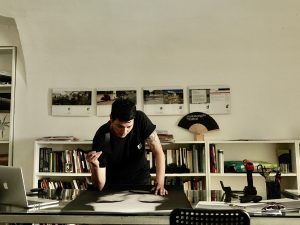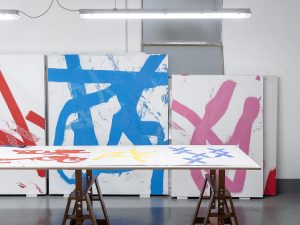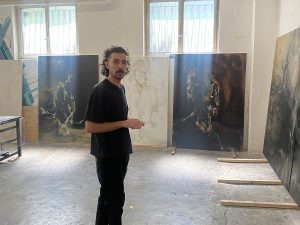Marco Senaldi
“I don’t know the future. I didn’t come here to tell you how this is going to end. I came here to tell you how it’s going to begin”
The Matrix
In some respects, it could be argued that The Matrix – the 1999 film that provoked both public acclaim and widespread debate among philosophers[1] – has been underestimated. Certainly, it did become a cult movie. But from a theoretical point of view, it is weighed down by the condemnation expressed by Jean Baudrillard. In an interview for Le Nouvel Observateur, in which he explained his refusal to be involved in the project’s sequel, Baudrillard argued that while The Matrix starts from correct premises – the murder of reality by artificial intelligence – it arrived at erroneous conclusions. If, in fact, reality has been totally replaced by a simulation, how would it be possible to admit that some rebels had saved themselves?[2]
But, even if the film’s dualism seems quite naive and although, in many ways (its taste for appropriation, its science fiction, cyberpunk style, techno music, and so on), The Matrix may appear to be a typical postmodern artefact, it still harbours a burning question. Indeed, one which is decisive more than ever now that the media hangover seems to have passed, namely the fatal question Morpheus asks Neo: ‘What is real?’
To answer this, we should consider the debate that arose at 1.30 p.m. on 23 June 2011, the day on which – according to his own scrupulous reporting – Maurizio Ferraris, at the urging of the German philosopher Markus Gabriel, coined the term ‘new realism’.[3] This definition would enjoy great success and in just a few years, an important discussion has developed around this theme.[4] It has, ultimately, produced an answer to Morpheus’s crucial question, instead of the usual, interminable questions to which philosophy, especially modern philosophy, had made us accustomed.[5] Yet in delving the term and concept of ‘new realism’ we risk finding ourselves dealing, as in the Matrix, not with one, but with two kinds of realism. What stands out in the texts and interventions that can be ascribed to New Realism, or neorealism (in the philosophical sense) is, in fact, the prefix itself – ‘neo’, ‘new’ – and the repeated invitations to ‘return’, ‘turn back’, ‘go back’ towards reality, ontology, reason, the Enlightenment, and the like.[6] But the prefix here associated with ‘realism’ – ‘new’ – is revealing, in such a context: it is, in fact, a ‘repetition’, betraying the anxiety that traditional realism is no longer enough, is not sufficient, and must in a certain sense be reactivated, since, for some reason, it had been interrupted and defused. This realisation, however, implies that reality, whatever we mean by that term, is not in front of us, but behind us; in fact, we return to it to realise that it was always there. Even the most obscure and disturbing version of reality, that is, the Real, does nothing but ‘return’[7] . But such a return has something strange about it, something schizoid. Realism, like all philosophical orientations, has a history: men are not realists by nature, and nor have they always been realists; certainly not prehistoric men, who lived in a world of fables, as Giambattista Vico put it. Classical realism, from Aristotle to Bertrand Russell, is, rather, a theoretical vision, according to which things are individual substances, determined by specific forms – consequently it is not ‘philosophy’, but ‘a’ philosophy, among others. But it is precisely here that the ‘new’ realism differs from its predecessor. For it asserts that ‘reality’ (and here the inverted commas are obligatory) is something immutable that, standing beyond our thoughts, ‘waits’ for us, motionless, at the bottom of the path of our mental wanderings.
The new ontological realism is, therefore, a ‘reactive realism’. It intends to constitute a ‘redemption’ moving away from the small and large falsehoods put forward by so many modern philosophers, from postmodernism’s denigration of the concrete in favour of the virtual, back to Heidegger’s hermeneutics, and Nietzsche’s ‘there are no facts but only interpretations’. This even leads to the hypothesis of a ‘Descartes-Kant-Nietzsche arc’, a sort of anti-realist Trimurti.
But at least one detail does not seem to fit with this version of reality as the ultimate, ineliminable, ‘unamendable’ background. To grasp this, it is worth analysing an explanation of Kantian philosophy offered by Ferraris during a TV appearance of his. In order to highlight Kant’s gnoseological revolution – which consists in placing the subject, rather than the object, at the centre of philosophical enquiry – Ferraris (using a very common metaphor) wears a pair of sunglasses, to reiterate that consideration of reality depends on the subjective ‘point of view’ (such as, indeed, a visual filter in front of one’s eyes)[8] . His gesture is meant to render the Kantian conception plastically, but it is carried out as part of a television recording. Ferraris ‘goes beyond’ the subject looking at this scene – or better, ‘objectifies’, rather than subjectifies, their gaze. What we see is a man wearing sunglasses, not what we would see from behind the darkened lenses. There would be only one way to effectively render the Kantian conception: to employ a ‘subjective’ shot; for instance, by placing the glasses not on Ferraris himself, but in front of the camera lens, which in the shot corresponds to the point of view of the watching subject.[9] This is not a simple communicative misunderstanding. A similar occlusion also emerges in key examples of the Manifesto, when it invokes a simple object such as a slipper.[10] It is such an object for me, for another person, even for a dog, a worm or even a plant, which, even if it cannot react, would have to adapt to the shape of the slipper, if it were placed in such a position as encounter it. In short, the slipper is ‘real’ – and is in general an object for any subject. But Ferraris, in his effort to isolate a ‘small piece of reality’, freezes it in a univocal, tautological existence, a ‘thing’ that cannot be anything other than itself – the ‘real’ that returns and to which one cannot help but return. Thus, he omits the only option that would prove that a slipper is not always itself – namely, its ‘aesthetic function’. A slipper is (and remains) a slipper, but it is something quite different if it belongs to my wardrobe or if it has been taken from an installation by Christian Boltanski, because in the latter case it takes on an – artistic, symbolic, but also economic – value that it does not have in the former case.
This is not just a paradox or an extreme (and thus insignificant) situation. On the contrary, it is strange that these philosophers have not taken into account the modus operandi of those who instead handle ‘concrete universals’, i.e. artists,[11] who have a peculiar relationship with reality. What does ‘concrete universal’ mean? That art – but contemporary art in particular – has always found itself plastically translating abstract concepts into tangible realities. Piero Manzoni, who, not surprisingly, studied philosophy, is paradigmatic in this sense. Merda d’artista (1961) is a philosophical concept and a ‘production’ (not a return) of the real – exactly in the spirit and along the theoretical lines of Marcel Duchamp’s Fontaine (1917), which is not an ironic calembour, but a very precise test, designed to bring into play the question ‘what is real?’, with the formula ‘what do you consider a work of art?’. And its concretisation in a vulgar urinal is a strongly, powerfully, ‘realist’ incarnation – but in a different sense from that of today’s apologists for ontological realism.[12].
Similar examples suggest that the balance of power between philosophy and art is being turned on its head: if, in the Renaissance of five centuries ago, philosophy managed to emancipate itself from subservience to religion, today it is art that is emancipating itself from its subservience to philosophy and to theory in general. The story involving realism is thus emblematic of this emancipation, and it also has a political aspect: artistic realism, in fact, does not at all have the character of a ‘return’; if it were, it would be discredited and ridiculous. Artists are the builders of a new reality that does not return at all, or rather – as Neo says in The Matrix – that is yet to come, and they do not merely ‘illustrate’ a philosophical position; if anything, it should be thought that makes good use of the ‘new reality’ constructed by art.
Gian Maria Tosatti’s installation My Dreams, They’ll Never Surrender, presented in November 2014, possesses this character of a ‘creation of the real’ and at the same time that of an impossible, ‘un-real’ challenge. The work consists of an authentic field of thousands of ears of corn, placed in an enormous, out-of-scale, dark, humid, hard-to-reach environment, like that of a water cistern, carved out of the ancient and imposing tuff fortress of Castel Sant’Elmo in Naples. Mario Francesco Simeone has written that the work constitutes ‘a challenge to the irreversible action of time’, a ‘rebellion in the everyday’.[13] . This kind of work is the bluntest retort to neo-realism: an ear of corn is, yes, an ear of corn, but an ear of corn forced to grow and survive thirty metres underground, ‘full fathom five’,[14] is both real and impossible, without being virtual or surreal, even though it appears to be so. The reality of art – of this art – is thus an ‘experimental’ reality: in the artist’s words, the installation is in fact ‘a litmus test’[15] , a phrase that closely echoes Duchamp’s statement about Fontaine: far from reducible to a ready-made, he defined it as ‘an authentic test’[16] . If we connect this idea back to the example of the thing-object in front of us (the ‘slipper’), everything changes depending on whether we consider it a simple ‘thing’ or a ‘test’: understood in this way, it is indeed a ‘test’, but precisely in the sense of a litmus test, a radical subjectivation of the objective world.
Operations like Tosatti’s, like Arcangelo Sassolino’s ‘dangerous’ installations, or Francesco Arena’s surprising installations, demonstrate the limits of philosophical realism: that is, not being ‘excessively’ realist and, on the contrary, having a still very narrow and one-sided conception of ‘reality’. Such works help us to ‘broaden’ the notion of reality.
Diplomazija Astuta (2022) by Sassolino, is composed of a series of incandescent molten metal splinters that plummet from above into pools of water, before the spectator’s eyes. Although it does not use video or digital images, it succeeds in translating the metamorphosis of matter into an emotive and ‘incredible’ spectacle, which prompts in the viewer the (obviously forbidden) temptation of ‘touching it with her own hands’. Ring (2020) by Arena, on the other hand, is a copper ring 410 cm in diameter, with a quotation by Virginia Woolf on the inside. The ring is set in the Vigna Barberini, in the days of the Roman Empire a terrace overlooking the Colosseum, and surrounds an ancient collapsed column, forcing our minds to turn their attention to this ‘piece of reality’ that we would otherwise have overlooked. Like Renato Mambor’s evidenziatori (literally ‘highlighters’; an unjustly forgotten but key work of the 1970s), Anello highlights an abandoned reality, and at the same time gives new meaning to Woolf’s phrase ‘The very stone one kicks with one’s boot will outlast Shakespeare’: the ‘stone’ in the form of an ancient artefact, actually has survived Shakespeare, and will also survive us who observe it today.
If we then try to look around us with total sincerity, in the same manner as artists do, we realise that it is possible to talk about realism, provided we start from an unprecedented broadening of the very notion of reality, which is so vast and unpredictable that it can encompass the most senseless and literally ‘unthinkable’ events that characterise the twenty-first century, from terrorist attacks with airliners to global pandemics, from complete lockdown to hybrid warfare.
What today’s art (and Italian art in particular) is producing and saying could constitute an effective complement to philosophy, today more than ever. This is perhaps one of the rare interpretative possibilities that is still up to the level of the epochal events of our time, an authentic ‘fresco of the present’.[17]
[1] See, for example, Pillole rosse. Matrix e la filosofia, edited by W. Irwin, Bompiani, 2006.
[2] A. Lancelin, Baudrillard décode Matrix, ‘Le Nouvel Observateur’, 19-25 June 2003.
[3] M. Ferraris, Manifesto del nuovo realismo, Laterza, 2012, “Prologue”. See also M. Gabriel, Fields of Sense. A New Realist Ontology, Edinburgh University Press, 2015, and Id., Perché non esiste il mondo [2013], Bompiani, 2015.
[4] In addition to the essays mentioned, there was a conference at Sofia University in 2017, with contributions from several voices, including Markus Gabriel.
[5] “Now, I am convinced that philosophy can provide answers, and that this is all the easier the more one leaves aside the philosophical refrain of the last century: the superiority of the question over the answer”, M. Ferraris, Manifesto, cit., ch. 1, p. 71.
[6] Another essay by Ferraris is significantly entitled ‘Welcome Back, Reality’.
[7] See H. Foster, The Return of the Real. The Avant-garde at the End of the Century, The MIT Press, 1996.
[8] M. Ferraris, Kant e l’Illuminismo, in the programme Il caffè filosofico, 30 June 2011, RAI 3, now visible on YouTube, < https://www.youtube.com/watch?v=LvlxOfm0vk0>. The metaphor goes back to Heinrich von Kleist, as Gabriel reminds us (in Why the world does not exist, cit., p. 10) – but von Kleist also calls the Kantian position ‘constructivist’ (i.e. ‘unrealist’).
[9] The history of the subjective as a film shot passes through cinematic masterpieces such as Robert Montgomery’s Lady in the Lake (1947), Delmer Daves’ Dark Passage (1947), up to videos such as Douglas Gordon’s Over My Shoulder (2003), shot entirely in subjective, with the artist’s arms and hands in-frame; see K. Thomson-Jones, Aesthetics and Film, Bloomsbury, 2008, p. 70.
[10] M. Ferraris, Manifesto, cit., ch. 2.
[11] The definition of an artwork as a ‘concrete universal’ can be found in Hegel’s Aesthetics: Lectures on Fine Art.
[12] For a philosophical interpretation of Merda d’artista, I refer the reader to Piero Manzoni. 1961 – Merda d’artista, edited by R. Pasqualino di Marineo, Carlo Cambi Editore, 2021, and to my essay therein, Il nulla sotto forma di qualcosa, pp. 34-41; for an interpretation of Fontaine in terms of an existential test, I refer the reader to my Duchamp. La scienza dell’arte, Meltemi, 2019. Markus Gabriel openly puts ‘works of art’ on the same level as things, since ‘everything is real, as long as you do not take it for more than it is’. But the work of art is exactly something that is – at the same time – ‘more and less than itself’. Thus, Gabriel’s reading of Malevich’s Black Square (in Perché non esiste il mondo, cit., ch. 6, Il senso dell’arte) as a ‘field of meaning’ betrays the anti-dialectical ontological approach of his entire framework: Malevich’s work does much more than ‘produce meaning’ – it is a ‘black hole’, a catastrophe, a void capable of ‘also producing non-sense’.
[13] M.F. Simeone, Effimero contro il tempo: l’opera di Gian Maria Tosatti a Castel Sant’Elmo torna fruibile, ‘Exibart’, 30 October 2022.
[14] ‘Full fathom five thy father lies’, from W. Shakespeare, The Tempest, Act I, scene 2; Full Fathom Five is also the title of a famous drippingby Pollock from 1947.
[15] M.F. Simeone, cit.
[16] ‘L’Urinoir fut un véritable test’, Duchamp told TV director Jean-Marie Drot in this latter’s documentary Jeu d’échecs avec Marcel Duchamp (1964).
[17] G.M. Tosatti, Il Neorealismo visivo, ‘Artribune’, VI, March-April 2016, no. 30.





